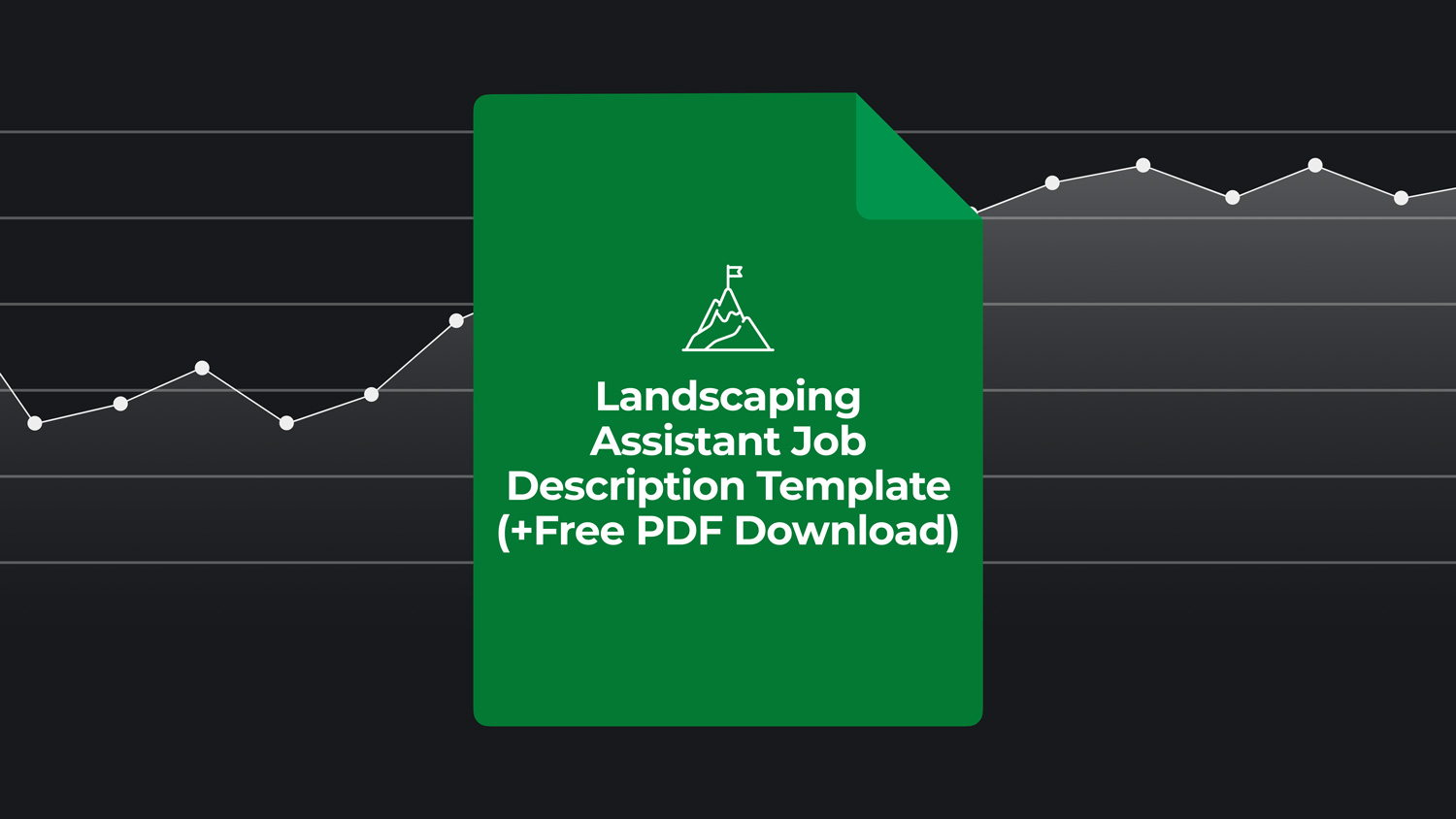Getting your landscaping business off the ground in this market can be a challenge. But here you are, running a growing business and paving the way to new heights of success.
As your company hits its stride, you may feel the road flattening out. At every point in a landscape owner’s journey, there comes the point where growth plateaus.
Not growing is the same as waiting to fail
High-growth businesses know that stagnating momentum is a red flag for a business falling behind. This can be tricky to identify because a slowdown in growth doesn’t reveal itself through a dramatic failure in business.
Operations can run smoothly, your marketing strategies are effective, new customer acquisition is on target, and you’re hitting your lead conversion goals.
But still, you may come to a point where you’re not growing as expected. This is normal for most businesses in the commercial or residential landscaping market.
Are you ready to act when you reach a pivotal moment in your business?
Slowed growth signifies a make-or-break point that business owners use to propel their landscaping company to new heights..
The problem with this opportunity is its out-of-the-blue nature, so it’s hard to navigate. This is where growth hacking can have an impact on the trajectory of your growth.
But what does growth hacking look like for landscaping service providers? Continue reading to find out.
Growth hacking in landscaping
First, let’s start by defining some things.
What is growth hacking?
In the simplest terms, it’s your ability to find creative and low-effort ways of fueling your company’s growth momentum.
Growth hacking strategies deploy low-cost initiatives to find points of impact that can:
Improve success
Increase revenue
Help a business scale
So what does growth hacking in the landscaping industry look like?
For landscapers, growth hacking revolves around your ability to address three aspects:
Optimization of operations
Scaling the business
Increasing workflow efficiencies
Just like in the field, your success in igniting business growth depends on maximizing the usefulness of what you have available.
This can include:
Organizational transparency
Standardizing workflows
Enhancing performance analysis
Eliminating department siloes
Cost cutting
Let’s dive into the five need-to-knows about defining your growth hacking strategies.
5 Growth hacks for landscapers
Focus on cost-cutting
Identify weak spots and blindspots in the business
Standardize and automate workflows
Create a scalable structure
Rely on comprehensive solutions
1. Focus on cost-cutting
No growth hack strategy can be considered a success if it costs you more than it’s worth.
Planning for rapid growth isn’t the same as your traditional marketing strategy, where you can make an investment hoping for a payoff down the road.
→ Remember: Growth hacking is about scrappiness and doing what it takes to give your company room to grow.
To do this, you need to understand a proposed strategy's impact, especially regarding the financial side of your landscaping business.
When developing a growth hack strategy, take these steps:
Start with cost analysis
Focus on thin margins with opportunities to be cut down
Analyze how much it’ll take to produce your new initiative, including:
Timeline to implementation
Temporary slowdowns in operations
Cost of implementation
Your cost analysis should be accessible throughout the entirety of the initiative.
→ A growth hack strategy payoff should be sooner rather than later—you must monitor the cost analysis of the initiative throughout its lifecycle.
The right preparation can influence your strategy’s success
For some, the first business to handle is optimizing your financial reporting. Far too many companies aren’t equipped to make financial decisions at the speed necessary to deploy a strategy that will deliver results.
Here are some red flags that may indicate your reporting abilities aren’t where they need to be:
You still have to wait on end-of-the-month reports to evaluate performance
You’re tracking finances in company-wide pools rather than on an individual task basis
You’re unable to forecast your margins properly
Getting visibility into your financial metrics before attempting to grow your business is crucial.
2. Identify weak points and blindspots of the business
Once you have your performance analysis, it’s time to focus on impact areas.
A pillar of growth hacking in the landscaping industry is finding areas of the business where you can have the biggest impact with the lowest effort.
Many companies go long stretches without taking a well-needed deep dive into the operational aspects of their business. That’s why many succeed with growth hacking strategies after performing a thorough analysis.
To find these impact areas, look for red flags such as:
Low visibility areas of the business
Processes that are siloed or disconnected from other company workflows
Areas with minimal insight into accountability or performance
Operations with undocumented workflows, procedures, or minimal training processes
A better understanding of your business enables you to grow intuitively
Keeping a constant and visible eye on the day-to-day operations of your business is key to finding growth blockers before they slow you down.
→ Live reporting and increased transparency empower proactive decision-making when opportunities arise, maximizing your ability to growth hack on the fly.
From the outside looking in, you don’t see the complex daily business decisions that play into a landscaping company’s ability to stay afloat and expand.
Even from the inside, business owners and leadership often focus on growth marketing and overlook the essential aspects of analysis and strategy that are integral to a business’s ability to grow.
3. Standardize and automate workflows
Manual processes and unsustainable workflows are often the weak points for businesses failing to fuel growth.
These tasks feel small at the beginning of your business when you’re a one-crew team, with staff working across departments in different roles.
→ As you grow and become a well-oiled machine, this culture is detrimental to growth.
It’s surprising how much of the day-to-day operations in a landscaping business can be automated or standardized in the modern era. If you’re a business that is stuck to those traditional workflows or generations-old processes, this can be your biggest growth hacking opportunity.
Workflows are the foundation for quickly growing your team
Find the workflows of your business with minimal documentation or onboarding. This signifies an area of operations that primarily relied on instinct or experience, making it a viable option for a trusted specialist but detrimental to onboarding new roles involved in the task.
Go through and document the workflow training, such as:
Creating a new customer file for a prospect
Following up on a sales call
Scheduling maintenance contracts
Review the documentation for inefficiencies or disconnections that slow down momentum.
Look at workflows as opportunities to make the most of your team’s time
Look at how your workflows connect. If you find specific tasks that don’t fit into the line of command or are missing from a chain of processes, then you have a problem.
→ In some cases, you may find workflows that are entirely unnecessary to the business or tasks that can be automated.
Finally, consider how technology can fast-track a workflow. There are many tools available that are equipped to remove some of your operational team’s workload.
Templates and standardized documents can benefit your organizational ability to:
Stay aligned
Maintain efficiency
Create company-wide standards of quality.
4. Create a scalable structure
Many businesses neglect to build a scalable business structure from the outset, creating one of the biggest needs for a growth hack strategy. The challenge of scaling creates many blockers that slow an otherwise successful business.
The strategies to scale aren’t always easy—and can be hard to pinpoint in a growing business—but not investing in processes that will grow with you means being unprepared for future opportunities.
Find the places in your business where you lack clarity.
To start scaling your business, focus on blind spots. If you don’t have visibility into your organization, you can’t find the blockers slowing you down.
Once you have 360-degree insight, it’s time to enable your workforce to perform their tasks with efficiency. Growth hacking means working with what you have without investing time and money into:
Hiring new team members
Expanding your service area or the solutions your landscaping company offers
Growing your customer base
The challenge is to find ways to propel your current staffing forward before you increase staff size.
Here’s what a scaled workforce encompasses:
Supported team management: From scheduling to routing, you need a management system that works on the fly and is accessible to each role on your team, so they know where they’re needed and when.
Fully equipped HR services: Your ability to recruit and retain talent requires trained HR specialists. Employee churn can be a significant momentum killer for growth.
An upheld and company-wide culture of inclusivity: Everyone needs to feel supported and embraced, from office roles to workers on the job site. An inclusive environment can be why talented employees choose your company over competitors.
Supporting your staff means giving them the tools, resources, leadership, and encouragement necessary to focus on being great at what they do. The result is improved employee retention to build an experienced and optimized workforce.
Without these structures, you’ll be too busy dealing with low accountability, underperformance, and company churn to enable meaningful growth–just a few of the reasons why landscaping companies lose money.
5. Rely on comprehensive solutions
The final piece of a successful growth hack strategy is ensuring you’re not spreading your efforts too thin. It’s vital to deploy high-quality strategies that can accomplish a wide range of goals without requiring simultaneous investment in multiple areas.
→ If you can find one investment in your organization’s growth that’s effective across multiple areas of business, then you’ve become a true growth hacker.
That’s why we put together a comprehensive, all-in-one guide to growth hacking for landscape and lawn care companies.
Our guide offers all the cost-effective strategies and resources you need in one place to grow your landscaping business.
The guide includes the following:
Tangible strategies that you can deploy at any stage of growth
Accessible resources to help get you going and templatize your strategies
Expanded insights on the info covered above
An opportunity to dive deeper into how Aspire’s platform enables you to succeed with all of these strategies
If your company wants to accelerate toward increased revenue, download our Guide to Growth Hacking in the Landscaping Industry today.
Use the form to tell us about your landscaping company, and get the guide in seconds so you can begin optimizing your growth strategies today.











